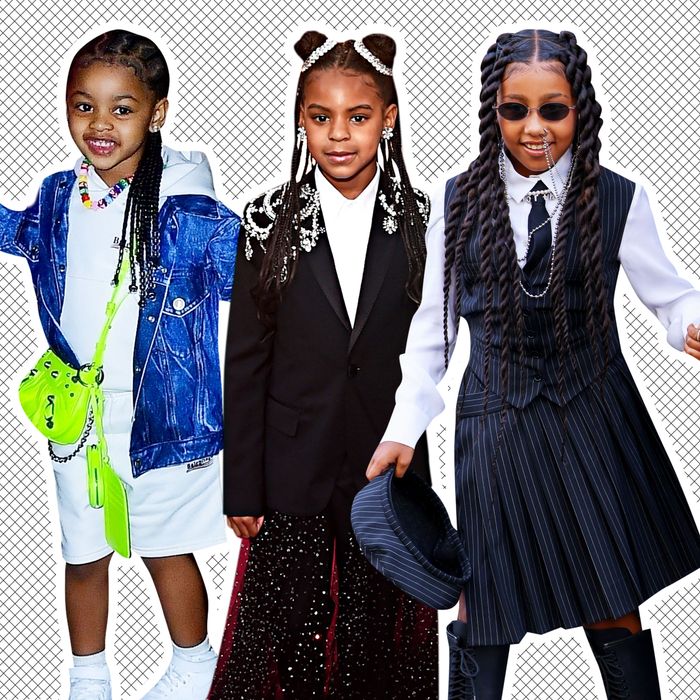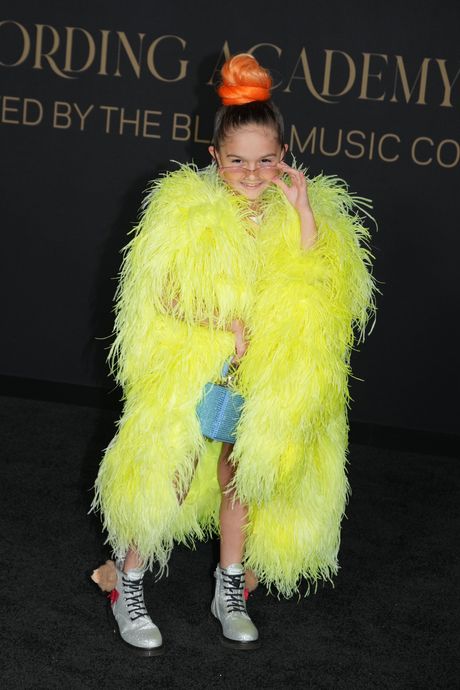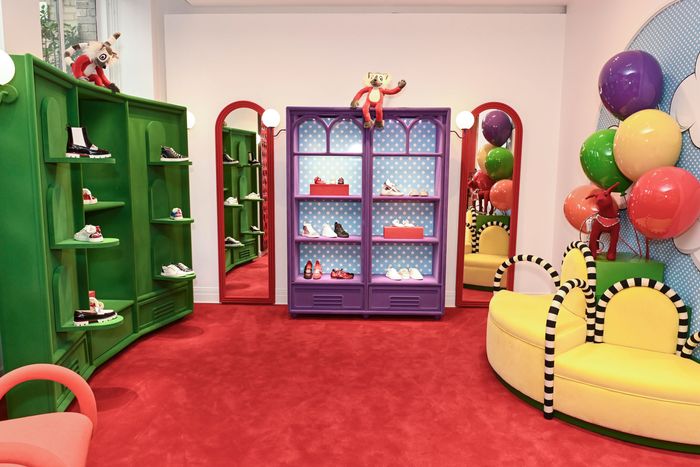
When Taylen Biggs attended her first runway shows, she was drawn to the bright colors. “I was really young, so I didn’t really understand so much,” she said. “Now I’m understanding the details, the stitching, the vibe, the angles, and the music.”
Back then, Taylen, a preternaturally articulate young woman with a high, tight ponytail and impeccable manners, was 4. Now, older and wiser, she is 9.
Taylen is part of a generation whose love of fashion and luxury labels knows no age. The affection, it turns out, is mutual. Having already established their stranglehold on stylish adults, brands like Versace, Fendi, Dolce & Gabbana, Givenchy, and Gucci are pushing further into the “lifestyle” space — a marketing euphemism for dressing you and everyone you know from cradle to grave.
High-design childrenswear has existed in some form for some time, from Armani Junior to Stella McCartney for Gap Kids, but the market is being scrutinized like never before thanks to a bizarre ad Balenciaga ran in November. There, amid a collection of high-priced wallets, rings, and sunglasses, was an angelic little girl wearing her own mini-versions of Balenciaga’s megahit Triple S sneakers ($595) and carrying a stuffed teddy-bear handbag that had first been seen on Balenciaga’s runway the month before. The problem was that the bear was wearing a leather harness that had a faint whiff of BDSM.
“What is this?” Tucker Carlson asked on Fox News. “Well, it is what it appears to be. It’s an endorsement of kiddie porn, of child pornography.”
The ads were promptly disappeared, but the damage was done. Stores on London’s Bond Street and Rodeo Drive in Beverly Hills were defaced by vigilantes. (“Not 4 Sex!!!” the graffiti artist wrote above two stick-figure children.) Carlson returned to the topic several more times. Kim Kardashian, who has walked the Balenciaga runway and wore the brand at the 2021 Met Gala, vowed to “reevaluate” her ongoing relationship with it. (Her ex-husband, Ye, whose collaboration with Balenciaga had been summarily cauterized when he expressed sympathy for Hitler a few weeks earlier, announced he stood with Balenciaga.)
But the real message of the ad campaign, now entirely drowned out, was not that Balenciaga wants to hurt your kids. It wants, at great expense, to dress them. It’s not the only brand competing for this market. Sales of designer children’s clothes have seen “tremendous growth,” says Dayna Ziegler, a senior vice-president at Saks Fifth Avenue, citing double-digit increases in sales on the store’s website. Saks recently launched collections from Amiri for kids (mini-versions of the L.A.-grunge staples loved by NBA players), Off-White for kids, and Christian Louboutin for kids (what the company calls, cutesily, “LoubiFamily”).
Even among luxury brands, where sticker shock is part of the elevated experience, it may seem gratuitous to spend hundreds, if not thousands, of dollars on garments whose life span is necessarily shortened by the vicissitudes of childhood: constant growth, the abrasions of the sandbox, a regular barrage of stains from nearly every source imaginable. It doesn’t pay to be too precious about babies’ and kids’ clothes, any parent can tell you. Unless, many designer brands seem to be saying, it pays to be extremely precious. The biggest growth at Saks, Ziegler tells me, is coming from the designer labels in particular. Among the store’s best-selling items are Louboutin patent-leather flats ($495), Burberry cashmere scarves ($280), and Moncler puffer jackets ($705 to $890).
Taylen, who first learned about fashion as a baby model for the Kardashian Kids collection, has been researching brands on social media since she was 18 months old, she told me. Zooming from her styling studio in her home outside Miami, Taylen walks me through her outfit. “My top is Dsquared2,” she says, “and I’ve got this Givenchy blazer on.” Taylen likes to mix high with low — her shorts are from Old Navy and her earrings are from Claire’s. She pans down to complete the look: She’s wearing her favorites, a pair of pink, plush teddy-bear house slippers. “They’re so comfortable,” she says.
Taylen’s love of fashion has turned her into a bona fide influencer — a transformation aided and abetted by her adoring mom, Angelica, who now stays home to manage Taylen’s career. (Her dad escorts her to shows as her “daddyguard.”) In a few days, she’ll head to New York for Fashion Week, though not before stopping to host the NFL Honors red carpet in the lead-up to the Super Bowl. Most of her designer clothes are gifted from brands looking for endorsements and posts. “My little brother is like 2 years old, so he doesn’t know too much but he actually styles me sometimes,” Taylen says. “I swear he does. He comes into my studio and he’s like, ‘This looks good.’ He puts glasses on me and all that stuff.”
Taylen isn’t in it for the money. She’s in it for the love of fashion. “I’m so happy that they’re coming out with kids’ clothes and they’re taking it from their fashion show to the kids’ department.” she tells me. “Fashion has no age.”
Celebrity children have become some of the most visible customers for luxury kids’ clothes. North West and Blue Ivy Carter have both been wearing brands like Fendi, Gucci, and Louis Vuitton since they were old enough to walk, and Kulture Kiari Cephus, the 4½-year-old daughter of rappers Cardi B and Offset, has been wearing Balenciaga and Burberry since she was barely out of diapers. But keep your eyes open and you can see similar kids in ritzy enclaves everywhere. A 30-something executive at a tech company with a 20-month-old daughter told me about a recent visit to the kiddie pool at a hotel in Miami: “I noticed three young kids who all had Gucci slides.”
Nick Axelrod-Welk, co-founder of beauty brand Nécessaire and a vice-president at United Talent Agency, told me he orders clothes for his 2-year-old daughter and newborn son almost exclusively from boutique labels in Spain, France, and the Netherlands. For parents used to expressing themselves through clothes, kids’ fashion represents an easily accessible transference of their old spending habits. Fendi Mommy may want Fendi Bambini, but for every style of parent dressing their child in their own image, there seems to be a corresponding kids’ brand. Axelrod-Welk and his husband, who live in Los Angeles, want to support the kind of small-batch, female-owned, good-for-the-planet companies for their daughter that they do for themselves. “It doesn’t have to be just wearing shirts with Mickey Mouse on them,” he says. “Which, by the way, is now all she wants to wear.”
Even brands whose alt-aesthetics wouldn’t necessarily seem like a sure fit have joined the game. Louis Vuitton — which will launch a baby collection in March — sure, but Rick Owens, Paris’s reigning prince of darkness? (He launched kids’ shoes in the fall of 2021, followed by clothes this past October.) Eli Russell Linnetz, the 32-year-old designer of ERL, whose colorful Pop clothes have been praised by Kim Jones at Dior and the editors of GQ, has been making childrenswear since 2021. “Every time someone finds out I do kidswear, they’re, like, shocked or in awe,” he says. “I never even thought it was weird until suddenly everyone asked me about it all the time. I mean the interesting thing is that people are willing to spend like $1,200” on these clothes.
SSense, the Canadian e-tailer that specializes in Bushwick chic, introduced kids’ clothes in 2021, stocking established luxury brands alongside independents who created pieces for the site, like Eckhaus Latta and Collina Strada. (“I think when we started, it would have seemed completely absurd to me — $300 baby sweaters,” says Zoe Latta, one-half of Eckhaus Latta and the mother of a 2-year-old. “Now, I self-identify as someone who would validate that purchase.”) Brigitte Chartrand, the vice-president of womenswear buying for SSense, says the ambition was to be a one-stop shop for its customers, locking in adult customers — many of whom are starting to have kids—and future ones, as well. The current selection of 60 brands will expand in coming seasons. “Back to school is a big opportunity,” she says.
Childrenswear has historically been dominated by legacy stores, some of which are falling on hard times. Babies ‘R’ Us is bankrupt, and Buy, Buy, Baby, the grimly named kids’ concern owned by Bed, Bath & Beyond, may be joining it soon. But if the old stores are gone, it’s not because the market is falling off. “This market is growing faster than menswear,” says Sylvana Durrett, the founder of the upstart children’s (and parents’) web shop Maisonette, who spent 14 years at Vogue, where she oversaw the annual Met Gala. “It’s growing faster than womenswear.” The total children’s apparel market is worth an estimated $252 billion.
Driving much of the growth is a new cohort of parents who insist that their children’s style harmonize with their own. “Eighty percent of our customers are millennials,” Durrett says. “Their values are incredibly different than our parents’ generation, their parents’ generation.” Most important, she says, “they want their kids to dress in a similar way to how they’re dressing, and they’re willing to splurge on certain things because now, you know, your family is your brand and you’re posting photos daily.”
The history of modern children’s fashion is, in some ways, a history of modern childhood itself. For much of the span of western civilization, children dressed more or less like their parents. “The children of Western European civilization were dressed until fairly late in the 18th century exactly like miniature adults,” wrote the costume collector and historian Doris Langley Moore in 1953. “Their quaint, dwarf-like figures appear in a multitude of family portraits, the boys swaggering a little, perhaps, in doublet and hose, in petticoat breeches, or wide-skirted coats and tricorne hats; the girls smiling, sometimes primly but often with great liveliness, in satin and lace, or in dark cloth relieved with white lawn — tiny replicas of their mothers and even grandmothers.” But as modernity dawned, so, too, did a conception of childhood that made space for a pre-adult period of prelapsarian innocence, of “natural,” Rousseauian naïveté. Children were allowed clothes their parents might not be — kids played in pants well before well-born adults did with the exception, Moore notes, of 17th-century “Italian clowns and comic actors” — and all the freedom that might go with them.
The children’s clothing industry as such self-consciously began in the 1910s and 1920s, transitioning from a handmade, hand-me-down market. Newly named phases of childhood were accompanied by — and influenced by — consumer categories tailored to them. As soon as there were toddlers, there was toddlers’ clothing. “The development of the toddler as a developmental and merchandising category is sort of interwoven, and part of it was the imputation of retailers,” says Daniel Cook, a professor in the Department of Childhood Studies at Rutgers University, Camden, one of the pioneers of the field in the U.S. (He was inspired to it in part by a job he had in the 1980s proofreading for a childrenswear trade publication.)
As the modern-day fashion industry began to take shape in the 1970s, children quickly joined their mothers as potential targets. Their status already buoyed by lower birthrates and a richer, older population of parents than in generations before, kids represented both a current and a future customer, and until they could deploy their own credit cards, they could be marketed to via their moms. Vogue Bambini, a childrenswear counterpart to Italian Vogue, began publishing in 1973, an illustrated guide to chic babyhood, which, though it slowed and then eventually ceased publication at the end of 2017, was for much of its lifetime a field guide to the care and clothing of the infant à la mode. GIÀ ELEGANTI blared the cover line for a 2009 issue featuring a towheaded toddler posed with her little chin in her little hand — Already Elegant. “Although Vogue Bambini claims to cover everything related to childhood, it no longer has any text articles,” the researcher Annamari Vänskä noted dryly in the mid-aughts: Mommy’s own picture book.
The luxury brands, in turn, have reclosed the gap created by the children’s market in its youth. Down with the ducks and unicorns, up with photo-ready chic. “Especially in the last, I’d say, three years, it’s evolved into a very new concept where it’s more fashion driven than it’s ever been before,” Ashley Petrie, senior vice-president of merchandising at Fred Segal, tells me. “It’s now almost things that adults would wear.”
I wanted to see for myself, so on a recent Sunday afternoon around nap time, I visited the ninth floor of the Saks Fifth Avenue flagship store, where the children’s section shares space with lingerie, winter coats, and L’Avenue, Saks’ ersatz châlet restaurant. Small groups of women browsed rack after rack of Burberry-checked essentials (3-year-old’s logo-print cotton-and-silk blouse, $340, dry-clean only) and investigated Rick Owens’ baby leather high-tops, which were only slightly larger than my palm ($600).
It was hard not to notice that many of the kiddie versions, from companies that often tout craft, were made in Tunisia, Portugal, and Vietnam while maintaining made-in-Italy prices. That leaves the logo to bear the responsibility for most of those dollars. The question of whether the clothes were accessorizing the children, or the children accessorizing the clothes, hung a little uncomfortably in the air. Or, in the words of an ad accompanying a Balenciaga hooded sweatshirt ($375), the wearer could be “90% Balenciaga, 10% Myself!”
Who these clothes are really for depends on whom you ask. For every fashion fanatic Taylen Biggs, there are many more like Atticus Slowey, a 10-year-old New York City fifth-grader with a floppy curtain of blond hair and a blithe disregard for the runes of designer logos. His mother, Anne, a former editor at Elle, tells me she noticed plenty of Moncler’s made-in-France luxury down ski parkas — like the best-selling ones from Saks — at her son’s downtown public school. But when Atticus came to the phone one weekday evening, he was unruffled. “I don’t pay attention that much,” he said. “I guess it’s just because I don’t have time to pay attention. I have to pay attention in class. I never get to, you know, walk around.” I asked him if the name “Moncler” meant anything to him. Nope.
“These kids couldn’t care less,” Slowey says. “I can tell you this: I was noticing, when these kids come out to play in the yard, everything is on the ground. We have these bins for lost and found, and there’s definitely choice designer items there.” A few decades in the fashion industry have cured her of any desire to participate. “I have a lot of guilt and I feel like a huge carbon footprint to work off that I won’t even if I have like two or three lifetimes,” she tells me. “I’m just trying to, like, clean up my own house a little bit. I buy T-shirts for my kids from Jacobin’s website.”
Meanwhile, the luxury brands are racing to meet kids where they are, like TikTok — where you can now follow, in addition to the influencer next door, Louis Vuitton, Gucci, Versace, and Dior — and Roblox, the gaming platform that, according to the company’s own estimates, is used by three-quarters of American kids ages 9 to 12. Gucci, which has created content for Animal Crossing and Pokémon Go, is especially bullish on Roblox, where it has introduced Gucci Town, a virtual community (with shops!) that has logged 39.5 million visits since launching in October 2021. (“All Ages: Suitable for Everyone.”) Robert Triefus, an executive vice-president at Gucci who was recently named CEO of its “metaverse ventures,” told analysts from McKinsey and the Business of Fashion that “we have proven to ourselves through these collaborations that the virtual world can create a very significant new revenue stream.”
Taylen Biggs, the influencer, will have plenty of time now to explore these virtual marketplaces: Her parents are homeschooling her so she can make the most of her time in the world of style. Her dream, she tells me, is to start a fashion line of her own one day. “It will be high fashion,” she says, and she’ll have plenty of guidance when she does. “I’m in touch with Olivier Rousteing,” the creative director of Balmain, one of her favorite labels, she adds. “He follows me on Instagram.”
She’ll have to keep an eye out for the next generation of fashion influencers already coming up behind her. Two years ago, Zara tapped Alastair McKimm, editor-in-chief of the British avant-garde fashion magazine i-D, to create a kids’ collection. He asked his 8-year-old son Lucien to be the campaign’s model, and there are signs that he’s already learned the lessons of the fashion world all too well. “He did tell me to warn his teachers at the beginning of the year that he was famous,” McKimm tells me. “Who knows what monster we’ve created.”







